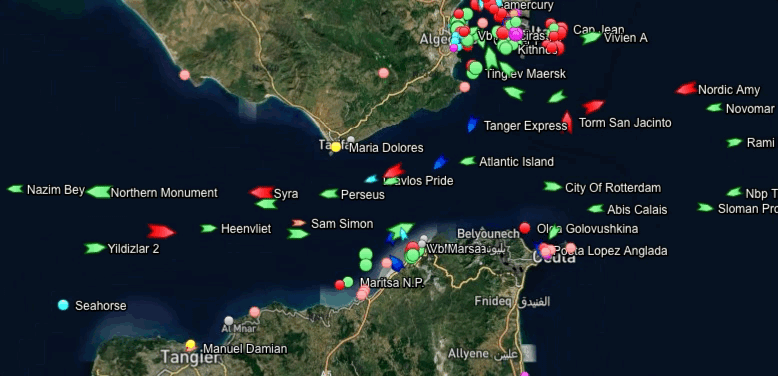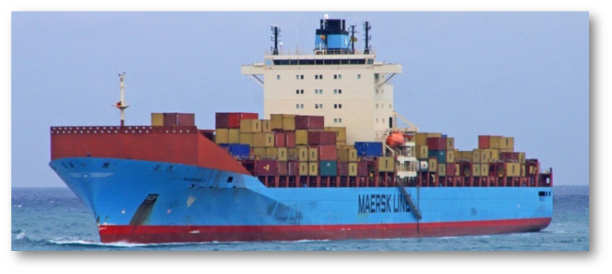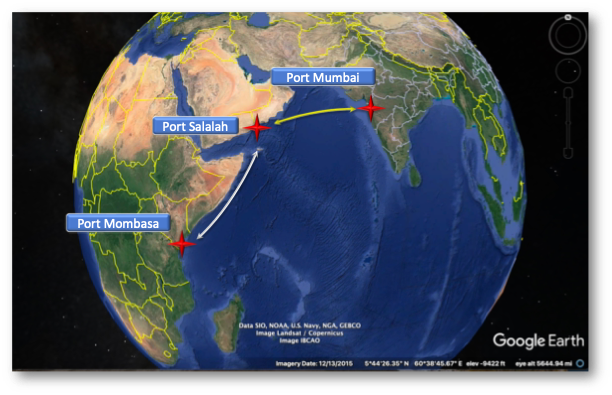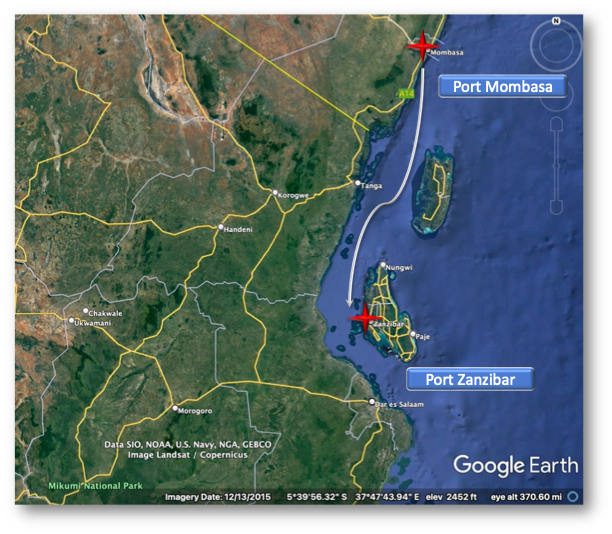Inquiry into the Seago Piraeus Mombasa Port Episode
By Jameson Matinho
Originally published August 19, 2022
Animated capture of marinetraffic.com
On December 13, 2021, a cargo ship docked at Kenya’s Mombasa Port as part of an Indian Ocean voyage. Unlike the other hundreds of imports the country annually takes in, this incident became a global pariah as port authorities detected radioactive substances in one of the ship’s containers. There are many identifiable nodes related to this incident that make it an interesting case study in open-source intelligence associated with important political significance. In this article, I provide a walk-through of a standard investigation using online publicly available information.
Maers
k
Seago Piraeus
First, I identified online news articles covering the event. This should be the primary step to get a broad preliminary basis for your investigation and find the key points which the rest of the investigation will follow. For this case, I chose one article written by Moses Odhiambo in The Star and two written by Anthony Kitimo in The Nation and The East African.
Open Source Asides: When conducting OSINT, it is crucial to always ensure the reliability of your sources. Nation Media Group is the largest media conglomerate in Kenya and owns both The Nation and The East African. It is a publicly listed company and is deemed trustworthy by the Open Society Program, but it is important to note that Aga Khan IV has a majority stake in the organization. In 2021, Freedom House rated Kenya’s internet freedom as partly free and determined that online information sources are not systematically controlled or manipulated by the government or influential actors. However, the report noted that Kenyan journalists may practice self-censorship due to arrests of online journalists and the government’s significant financial influence from advertising purchases. Still, these articles supply important nodes pertaining to the Seago Piraeus incident that are helpful for subsequent research.
Source: Open Society Foundations. Mapping Digital Media: Kenya February 5, 2013 p. 27
These articles reference a few key nodes pertinent to the incident: the cargo ship transporting the container, the container identification number, the company that loaded the container, and the names of individuals relevant to the case.
Each article mentions the name of the vessel as the MV Seago Piraeus. First, I googled this name, and instantly found important information on the cargo ship. Notably, I was able to identify the vessel’s IMO number, a crucial identification source in acquiring maritime information. I gathered facts about the vessel using a pdf from cargo-vessels-international.com. The ship had two other names before it was “Seago Piraeus”, demonstrating the importance of the IMO no. 9313955 in case we need historical information under the vessel’s past names. This file also gives us the country’s flag that Seago Piraeus flies, Denmark, and the ship manager of the vessel--AP Möller, also known as the massive shipping conglomerate Maersk.
Travel Prior to Incident
According to one account, Seargo Piraeus traveled from Mumbai and arrived in Salalah December 13 or 14, 2021; however, AIS data for this time was not found.
The article from the East African tells us the identification number of the high-radiation level container: TCKU3337296. This code comprises of the following: an operator code of 3 letters, an equipment identifier as the fourth letter, a serial number consisting of 6 numbers, and a seventh digit used for validating the accuracy of the previous data. An identification code register reveals that this specific container is owned by Triton Container International LTD. Using the unit search tool from Triton’s website we can find background hiring information on the container and confirm that it is currently being leased by Maersk. Additionally, using the container identification number, I found publicly available information which reveals the ingress of the container via the Seago Piraeus into Mumbai’s Nhava Sheva Port at 0030 Indian Standard Time on December 25, 2021. Information from the Seago Piraeus’ journey shows that it berthed in Salalah Port, Oman on December 22, 2021.[4] Unfortunately, I did not observe any information on what ultimately became of the contents within the container following its quarantine in Mombasa.
Order to Return
Following quarantine and inspection in Kenya, the Public Health Authority ordered the cargo to be sent back to India. By December 18, 202`, the Seago Piraeus left Mombasa with Salalah as its next stop. The vessel arrived in Mumbai on December 25th, 2021, where container TCKU3337296 was dispatched.
Each article mentions that the cargo was to be picked up in Tanzania by a man named Hafidh Ali Hamad. In this investigation I found references to man with this name in Tanzania using simple google search queries. This included limited export and import data via volza.com blocked by a paywall and multiple PDFs with similar information. However, I did not observe crucial information of social media accounts, any ties to an import company, phone numbers or email addresses, or even whether or not the data I found is about the individual of the same name destined to pick up the shipping container.
Intended Destination
Prior to the radiation being discovered in Mombasa, container TCKU3337926 was destined for Zanzibar. There, the cargo was set to be received by Hafidh Ali Hamad.
The company that dispatched the container is named Prama Exports. Using boolean logic, I searched “Prama Exports” using an online search engine and found a business listing site that depicts the company’s Goods and Services Tax Identification Number (GSTIN), pictured above. And before you ask, the answer is yes, I could not find a higher quality image. The GSTIN is based off India’s permanent account number service and since it is administered by the Indian government for tax purposes, it can be reliably linked to publicly available financial information. After using online GSTIN search engines, I confirmed the existence of Prama Exports as a financial entity. Using business listing sites and other online sources about Prama Exports found from google-dorking, I found the names of individuals and both phone numbers and emails associated with the shipping company. Even in the image pictured above, you can see the name of an “advocate”, likely a proprietor or representative of Prama Exports, cut off on the left side. This information can reveal crucial information about the owners or other companies related to a company, but subsequent research regrettably did not expose such material. While I was able to identify the names of a few employees of Prama Exports and their contact information, I have decided not to include their names in this publication because I did not observe any evidence of their culpability or other clearly useful information. I did, however, find the principal address of the company, the active status of their GSTIN, their GSTIN registration date, and their constitution as a partnership. Additionally, India’s GSTIN search website reveals that Prama Exports deals in the export of sugar, measuring devices, twine, baked goods, and a category named “other”. The article from the Star states that the items listed by Prama in the shipping container was padlocks, which begs the question of how they were able to load the reactive materials in India and, of course, why they did this.
Prama Exports
Image of Prama Exports’ office, showing GST number assigned by the Central Board of Indirect Taxes and Custom (CBIC)
Image courtesy of Justdial
Although this investigation did not explicitly find who was at fault for the Seago Piraeus incident in Mombasa on December 13, 2021, it demonstrates the increasing importance of open-source intelligence. I found important information on entities in Kenya and India despite a lack of observed government documents. According to Transparency International, “67% of people thought corruption increased in the previous 12 months” in Kenya and “89% of people think government corruption is a big problem in India”. Historically, African nations have issues with nuclear waste dumping corruption related to this crime. In The East African, maritime consultant Andrew Mwangura noted that waste dumping by developed countries in the Western Indian Ocean region continues to be commonplace. Corruption is present in another alarming sector related to the Seago Piraeus incident: India’s nuclear facilities. In 2020, the Nuclear Threat Initiative ranked India 20 out of 22 for most secure nuclear producing countries, only making it more secure than Iran and North Korea. OSINTers, investigative journalists, and laypeople should continue to scrutinize cases such as this. If individuals and communities mobilize for this purpose, we can hold entities responsible accountable for their crimes and pressure governments and private companies to be more transparent with their operations.






